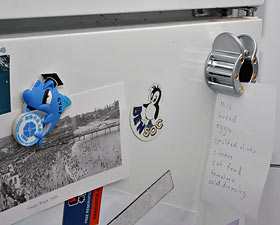<H1>I'm getting into this!
</H1>
http://www.dansdata.com/wineclip.htm
<H1>The Wine Clip</H1>
<ADDRESS>
Review date: 13 August 2004.</ADDRESS>
<ADDRESS>
Last updated 04/12/05.</ADDRESS>
One day, the makers of
The Wine Clip contacted me with a cheerful e-mail, asking me whether I'd like to review their product, which claims to "Age wine instantly using magnetics".
That's right. You can take a young, callow, brash and uncouth bottle of cheap red hooch (white wine may benefit, but the thing's made for red), use The Wine Clip on it, and the result will allegedly be... well, not
Grange, but distinctly better than it was. It's not meant to be a subtle difference that only Golden Palates can detect; The Wine Clip is a product aimed at anybody who enjoys red wine.
The Wine Clip (the company name's the same as the product name) know their claims don't sound very likely. So they've got
testimonials, they've got a
downloadable video of a blind taste test, and they've got a
satisfaction guarantee. And the thing only
costs $US39.95, ex shipping.
So this, I had to see.
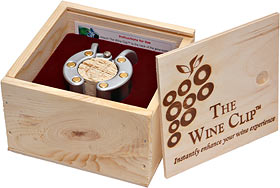
The Wine Clip comes packaged in a rustic little wooden box, with a business-card-sized instruction sheet that tells you how to use it.
It ain't rocket surgery. You just clip the spring-loaded device onto the neck of a wine bottle...
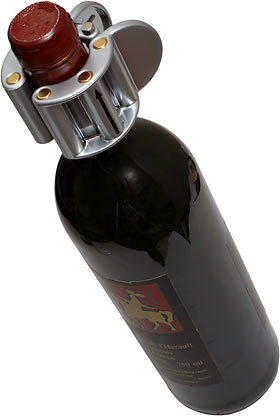
...and you're ready to go.
Well, y'know, as long as you've already taken the cork out.
The instructions tell you that you probably ought to align the Clip so that the arrow on the side of it points towards the mouth of the bottle, but that it might work better the other way around, in some cases.
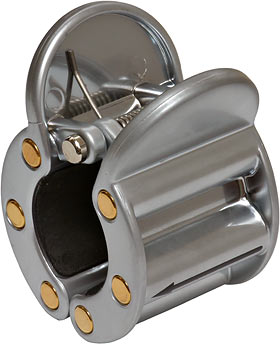
The Clip itself is made out of silvery plastic, with six strong rare earth cylinder
magnets embedded in it. The magnets are about 40mm long (1.6 inches), but only about 6mm in diameter (a quarter of an inch); six similar magnets would cost you well under $US10 if you bought them separately from a place like
ForceField or
Engineered Concepts. The whole Wine Clip weighs about 98 grams (3.5 ounces).
<H3>Alternative physics</H3>
According to the Wine Clip site, "When a conductive fluid (in this case wine) passes through a magnetic field, an electrical charge is created. That charge effects [
sic] the molecules that are suspended in the fluid. These loosely bonded and larger molecules are broken down into smaller molecules."
They go on to say "With The Wine Clip, a wine's impurities and tannins are broken down during the pouring process. There is absolutely no chemical change and nothing is introduced or taken away from the wine. It's the physical change which accounts for the enhanced flavor and bouquet. The taste of many small molecules is smoother than the taste of fewer large molecules."
Well, it's true that tannin levels have a lot to do with the harshness of a young red wine, but the above description is self-contradictory. If you're breaking down "impurities and tannins", you're making a chemical change. Impurities and tannins are chemicals. Duh.
(Tannins are not clearly defined chemicals, by the way; they're just any astringent substance that resembles tannic acid, which is used in leather tanning and ink-making.
Winemakers add "fining agents" to the wine to help remove tannins.)
I'm
highly skeptical about the notion that magnetic fields can do anything like what the Wine Clip's promoters claim. As far as I know, you can pass various liquids through magnetic fields all you like, and the composition of the liquid coming out will be just like the composition of the liquid going in, unless there were iron filings suspended in it on the way in, or something.
Which is just as well, when you think about it. If The Wine Clip can break molecular bonds in tannins, who knows what else it might do? If it ripped apart the
ethanol molecules then you could end up with hydrogen, oxygen and
acetylene bubbling out of your booze.
Where the energy to break molecular bonds is supposed to be coming from, here, is also hard to say. Yes, passing a conductive substance through a magnetic field will induce a current in it, but just pouring wine through a static field couldn't, even in physics-experiment-land, give you enough juice to even
electrolyse a noticeable amount of the wine's water into hydrogen and oxygen, much less break down its tannins.
It's hardly a waterproof argument to say "if this worked, the winemakers would be doing it at the factory", but there
is truth to it. There are tons of hokey magnetic wine/water/fuel/whatever treatment devices out there; they're hardly a new development (I've talked about them myself on
previous occasions), and pretty much all of them would be multi-billion dollar major-industry products, if they actually worked. But whaddaya know, they're just sold in small numbers to regular consumers. Because they
don't work.
Subatomic particles may start acting very strangely in
monstrous magnetic fields, but the field from permanent magnets like the ones in the Wine Clip is, thankfully, far too weak to do that sort of thing. The threshold for any such effects is at least millions of times what any permanent magnet yet known can achieve, and possibly hundreds of billions of times.
If magnetic fields broke down tannins or anything else, and if the Wine Clip people were for some reason the first to discover this phenomenon, then they could substantiate their claims empirically. The
chemical structure of the various tannins is well known, and they can be, and routinely are, detected and quantified. If all you care about is basic tannin concentration - which is apparently what the Wine Clip's meant to reduce - then you can test for it in a high school science lab.
Again, it's just as well that magnetism doesn't change molecules; science labs routinely use magnetic stirrers (little ferromagnetic stirring rod with inert coating goes in the liquid, rotating magnetic field is applied from beneath, rod spins around). They probably would have noticed if the composition of the substance under test changed just because they stirred it.
But just because people don't know why something works - or can't coherently explain it - doesn't mean that it
doesn't work. Many seemingly
ludicrous notions have turned out to be true, though of course many
more ludicrous notions have turned out to be as false as they
seemed.
According to The Wine Clip, the
taste tests tell the story.
I can't say I was terribly impressed with the test depicted in the above-linked video, though.
The "
blinding" of the tasters was questionable, to start with. All the tasters did was turn away from the person pouring wine with and without the Clip into their tasting glasses. You don't actually get to see the pouring, so you can't tell whether people peeked. Even if they didn't, it's quite possible they could hear when the Clip was put on the bottle and which glass was then filled. The tasters shouldn't have been in the same room when the pouring was done.
The video test also seemed to only be single blind. Perhaps the people administering the test didn't know which glass was which either, but no mention was made of such a precaution. When the tester knows what the subjects are getting, he or she can accidentally or purposely influence the results.
And this, of course, is all assuming that the whole thing wasn't just rigged. Anybody who knows a small amount about stage magic knows that nothing helps a trick go off perfectly quite like a "volunteer from the audience" who's on your payroll, but it doesn't have to be that much of a conspiracy. Perhaps there were more test runs that we didn't see, and the video was edited down to exclude the negative results. And when people make their choice, one of two pieces of paper on the table in front of them was turned over to reveal what they chose. But the
other piece of paper was never turned over. Both pieces of paper could say the same thing, for all I know.
(Yes, one person in the video chooses "poorly" and prefers the un-Clipped wine, but if I were rigging a test that's how I'd set it up; a 100% positive result looks too good to be true.)
All of the above suspicions could be allayed by the presence of some plausibly unbiased observers, perhaps from a wine magazine, though an actual off-duty scientist or two would be better. But there weren't any.
Now, you don't need fancy gear to do science in your very own home. See
this Therapeutic Touch experiment, for instance; there's often no need for white coats and extensive Pyrex collections.
So I decided to test The Wine Clip properly myself.
<H3>Experimental protocol</H3>
I wanted to do a half-decent double blind test - where neither the people being tested, nor the person administering the test, knew which wine had been treated and which hadn't. To do that I needed a co-experimenter (so one of us could set stuff up and the other could conduct the tests), as well as some <STRIKE>victims</STRIKE> test subjects.
The co-experimenter I found at the other end of the hall; the test subjects took longer to round up.
But, eventually, we had four people with reasonable red wine experience, and four wines to try the Clip on.
The four wines in question were a 2003
Oyster Bay Pinot Noir, a 2000
d'Arenberg "The Custodian" Grenache, a 2002
Ingoldby Shiraz, and a 2002
Clare Valley Mockingbird Hill Cabernet Sauvignon.
The four people were three journalists and an economist. So they all had good reason to drink.
The tasters and my co-experimenter waited in the dining area while I prepared the samples for tasting in the closed-off kitchen.

This made me feel like a kind of low-rent
Rob Cockerham.
Each of the four tasters was presented with four pairs of cups, one pair for each wine, one wine at a time. Three of the pairs comprised one un-Clipped and one Clipped sample (I tossed a coin to determine which would be which, in each case); one pair was a fake, where the two samples were the same. For two of the tasters, these identical samples were both un-Clipped; for the other two tasters, the identical samples were both Clipped. Each taster's fake pair was a different wine.
I used The Wine Clip in the basic, arrow-towards-the-mouth-of-the-bottle alignment.
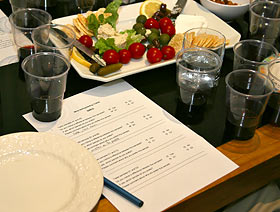
The tasters each got a survey form on which they could note down whether they noticed a difference between each of the two samples. They weren't told whether there'd
be a difference, or what was actually going on in the kitchen. All they knew - or, at any rate, hoped - was that this wasn't some kind of Candid Camera stunt.
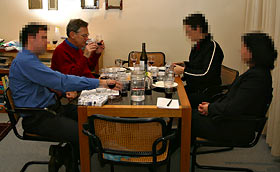
Three of the tasters requested anonymity. The fourth one's the esteemed
ABC war correspondent Greg Wilesmith, now Executive Producer of the excellent
Foreign Correspondent. He wants all the publicity he can get.
The experimental process was convivial, thanks to my tendency to put too much wine in the sample cups, and the tasters' tendency not to spit it out. But we maintained good blinding throughout, and no samples got mixed up, and my co-experimenter was pretty good at stopping the tasters from conferring during the test.
While I waited in the kitchen for the tasting to conclude, I tried an utterly unblinded taste test of my own, putting the wine in two completely different glasses, to boot. The un-Clipped wine in the cactus glass tasted the same to me as the Clipped wine in the daisy glass. That was what I was expecting, of course, and I don't know from wine anyway.
Eventually, we came up with some...
<H3>Results</H3>
The testees were primed by the very nature of the test to expect differences between the wines; they commented afterwards that they were trying to find them. So it's not surprising that they did.
When people actually had "different" samples - one Clipped, one not - they perceived a difference between them 83% of the time (10 times out of the 12 non-fake sample pairs). However, exactly half of those results preferred the Clipped wine, and half preferred the un-Clipped wine. This is exactly what you'd expect if the Clip did nothing and they were only imagining a difference.
In the four cases, one for each taster, when they had "identical" samples - both Clipped, or both not - they still perceived a difference 50% of the time.
Now, you could claim from this that the Clip actually is doing something - inflating a baseline 50% rate of perceived difference to 83% - but the 50% figure is based on only four tests, so a small error margin will create a big apparent change, that isn't actually
statistically significant. If a hundred tests of one thing give an 83% result and a hundred tests of another give 50% then you're very probably looking at a real difference, but in a situation like this when an error of plus or minus one gives a result range of 25 to 75%, you shouldn't get too excited about the importance of that result.
I'd uncorked the wine for a while before pouring it, to let it "breathe", but it was only breathing in the bottle; all of the testers agreed that at least some of the samples differed considerably in taste when they'd been sitting about in the tasting cups for a while longer. It was also pointed out that the first few pourings from a bottle are likely to taste somewhat different from later pourings, both because of oxidation and because there's more sediment lower down. I always did the Clipped pourings after the un-Clipped ones (to avoid Clipped backwash from the neck of the bottle contaminating the rest of the wine), so that could have accounted for some differences, too.
What more could I do? Well, I could arrange another test with more fake entries, and preferably with more tasters and more wines as well, and see if the 50-versus-83% thing held up under more intense testing. But we needed 32 cups just to do
this test; that's already 18 more than The Wine Clip apparently used in
their video test. They made no effort at all to see whether people would perceive a difference between samples even when the Clip wasn't used on either, or was used on both.
I also did all of the Clipping with the arrow on the Clip pointing towards the end of the bottle; the instructions have a bit of an each-way bet on that one, so maybe I should have run the test again with the arrow pointing the other way. I
am in the southern hemisphere, after all.
The executive summary, though, is that all of our coin-tossing, sorting, pouring and tasting turned up no evidence that The Wine Clip has the definite positive effect its manufacturers claim. Perhaps we missed something, but we did a better test than they did. I don't see a reason to invest more time in testing this unpromising device. Particularly when it's hardly a new idea.
<H3>The pedigree</H3>
Magnetic liquid treatment devices are common enough. Some are meant to produce "energised"
water, some to "soften" or otherwise improve water or fuel, and the pseudoscientific jargon used to justify them can be, if not impressive, at least
amusing.
The Wine Clip's designers say (in their tasting video, and
elsewhere) that they started out making "industrial" magnetic water and fuel treatment devices. They say their gadgets are used by "nuclear power stations [and] the US Navy". They're not talking about magnetic sump plugs and other prosaic devices that just sweep ferromagnetic material out of passing liquid; they're talking about devices that do Wine Clip-ish things to other fluids.
Extraordinarily enough, there actually is
some reason to believe that some magnetic water treatment devices, specifically those used to reduce scaling problems in recirculating water systems, have some value. It's far from definite, and nobody's been able to come up with a sensible reason why the things should work, but at least
some science supports the idea.
The most common magnetic liquid treatment devices, though, are the ones you strap onto "once-through" non-recirculating pipes of various kinds (home water pipes, automotive fuel lines). These
devices are, basically,
scams (well, except when even the
people that sell them don't claim that they work). But people buy enough of the things to keep various
companies in business.
If you want one of these things, you can of course
build it yourself and get a more magnetically powerful, yet much cheaper, solution.
<H3>Overall</H3>
It's easy to make fun of wine experts who use an extraordinary range of apparently irrelevant adjectives to describe the flavour of wine, especially if you don't know much about their field of expertise. I'm sure that some of those "experts" are really and truly making it up as they go along, but the general consensus is that sensible wine critics may speak of "blackberry" and "cut grass" and "toast", but are actually using the words more as jargon than as literal descriptors. A "toasty" wine is unlikely to actually taste as if burnt bread's been marinated in it, but
will have a flavour (probably imparted by a well-roasted wooden barrel) that's vaguely reminiscent of that taste. Fair enough.
Still, though, when you see "
overwhelming"
testimonials from various allegedly respected wine experts regarding the extraordinary qualities of The Wine Clip, and then try it under controlled conditions and find that it doesn't seem to do anything, you've got to wonder how objective these people are actually being. There's no reason to suppose the wine aficionados are any less foolable than hi-fi enthusiasts who're convinced they can hear the difference between cheap and expensive speaker cables even if, unknown to them, the cables are
not actually being changed at all.
If this foolability extends into the wine experts' day jobs - which it probably does, since people seldom review wine in a controlled environment - the whole business of wine reviewing starts to look distinctly shaky.
Oh, and then there's
John Sculley, there on the Wine Clip
testimonials page too, saying that he liked the Clip so much he invested in the company. The Wine Clip's Director of Business Development thought this was something of a selling point; his exact words to me were "John Sculley, former CEO Apple/Pepsi, is a major advisor and investor, so this is not a hoax."
I can't, you'll be startled to learn, say that I entirely agree with this line of argument. I don't think John tested The Wine Clip in controlled conditions, I don't think he invested a significant amount of his net worth in it, and it's not as if very rich men haven't had
funny ideas about things from time to time, anyway. And, of course, an investor in a weird product may well suspect that it's snake oil, but also be pretty sure that it's snake oil that people will
buy.
It occurred to me, not long after receiving my review Wine Clip, that its laws-of-physics-defying nature might make it eligible for James Randi's famous
Million Dollar Challenge, which offers an (as yet unclaimed...) cool million US dollars to anybody who can show "evidence of any paranormal, supernatural, or occult power or event" in controlled circumstances. It's not just for psychics and spoon-benders; pretty much any claim that's grossly at odds with consensus science would qualify for the prize.
I e-mailed Randi to ask him about The Wine Clip, and he said "Yeah, I noticed this years ago. It's an old idea. We already offered them the prize, but they did not respond."
When I asked the Wine Clip people to comment on this, they stopped answering my e-mail.
There's a winery in Canada that ages wine
under a pyramid. They
say that tasters overwhelmingly prefer wine that's been "placed in sacred geometry". This claim'd win them Randi's million bucks too, if it were true. But, like lots of other things people have said about
pyramids over the years, I doubt it actually is.
Why is it, I wonder, that magnetic treatment never seems to make anything
worse? Everything always lasts longer, tastes better, cuts cleaner and shines brighter when it's been graced with magnetic magic. Somehow, magnets know the purpose of the thing they're applied to, and make it better suited
to that purpose. Presumably they'd make bad
moonshine less poisonous, but bad weedkiller
more poisonous.
The Wine Clip isn't the only product in this market segment.
Wine Cellar Express is a magnetic coaster which is supposed to do the same thing as The Wine Clip;
The Perfect Sommelier gives you a coaster and a cork. They each cost about the same as The Wine Clip, and I feel quite confident in saying, without even seeing them, that they offer exactly the same value for money.
Intelligent people all over the world believe
dumb, or just
very very peculiar, things - despite the best efforts of curmudgeonly
scientists to spoil everyone's fun.
In the great scheme of things, The Wine Clip's claims aren't particularly pernicious. There are
reprehensible quacks out there who, perhaps maliciously and perhaps sincerely, spout more
new dangerous nonsense with each passing day, and commonly employ pseudoscientific explanations similar to the Wine Clip spiel. The Wine Clip isn't even playing the same
sport as those people, much less in the same ballpark; they're not promising a
cure for anything.
But I can't get away from the suspicion that every time someone's convinced, by a nonsensical explanation or flawed test, of the reality of a nonexistent phenomenon, the world's stock of rationality is slightly depleted. And, therefore, the cause of the actually dangerous
pseudoscientists is advanced.
Yes, The Wine Clip has a satisfaction guarantee, but it's an open secret in the world of consumer protection that people seldom bother to claim on such guarantees, unless the item in question is expensive, which The Wine Clip isn't. Lots of people are used to paying more for a few bottles of hooch than the Clip costs.
And, of course, there's the well-established tendency of people to believe in things that they've paid for, because otherwise they'll feel like a bit of a goose.
I'm therefore not surprised that The Wine Clip has so many testimonials in its favour, and I don't think any of them are fake. The world has an ample supply of people making good money out of
complete gibberish, and there's also no shortage of people who've managed to convince themselves of the value of sundry expensive, unproven
medical devices,
psychics, and
subtle energies, of
long-distance psychic healing for pets, of
chakra databases, of mystic
healing of diseases that afflicted you in the
past, and of 101 flavours of
quantum nonsense. Not to mention the presence of all kinds of unlikely things
on Mars, or the idea that
turntables that cost $US12,000 without a tone arm are good value, or that cat noses need to be
shaved. Opinions differ pretty widely about just about
anything you care to name.
The
placebo effect works just as well for a wine-flavouring gadget as it does for a
medicine, because people are, naturally,
suckers. If we weren't, we wouldn't need science.
The modern USA is a country that needs an actual
body to "Defend the Teaching of Evolution in the Public Schools", for Pete's sake. No wonder you can find a market there for wine magnets.
I, however, have found only one thing the Wine Clip does well.
